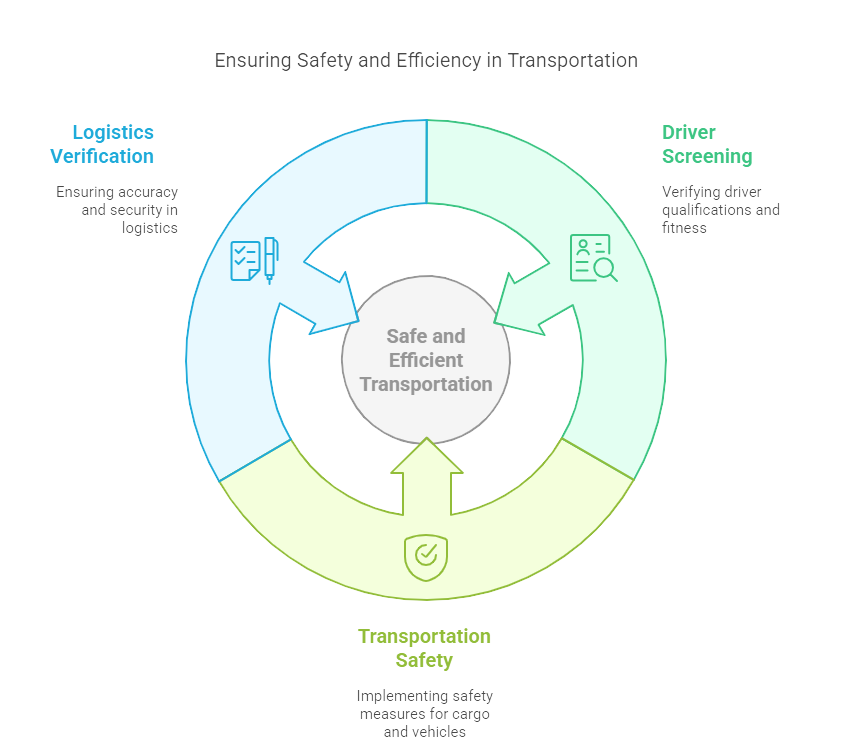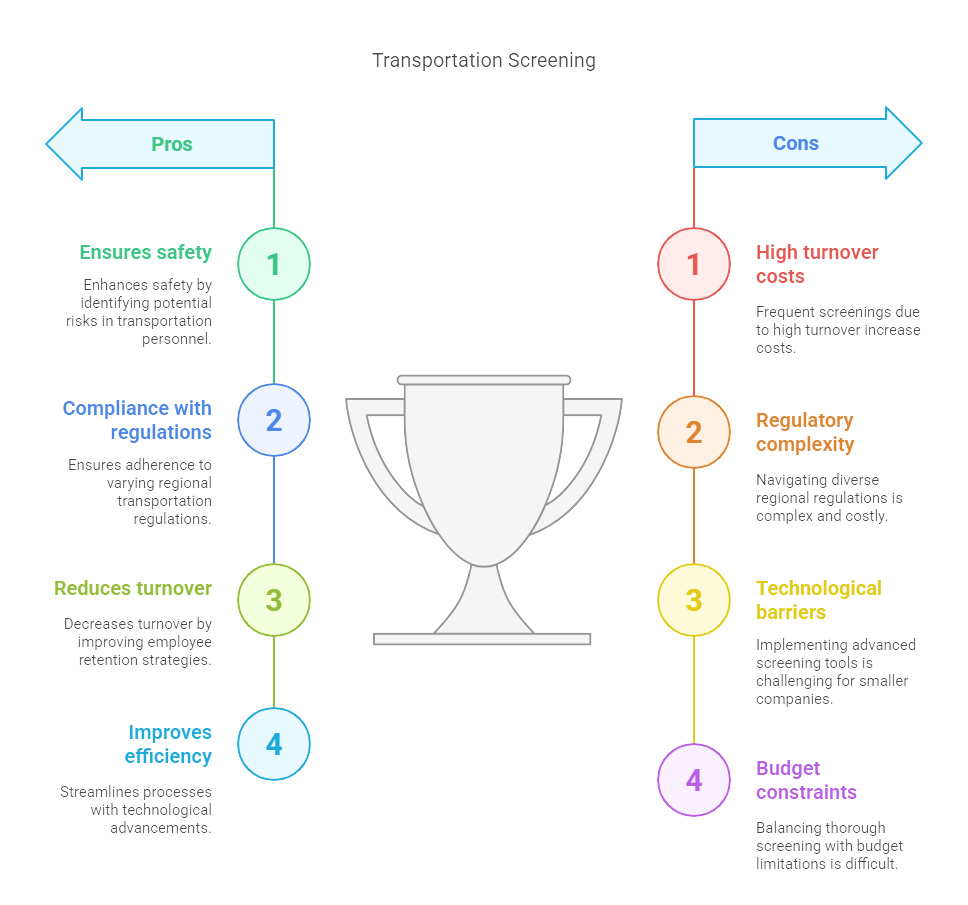Screening processes in the transportation industry play a vital role in ensuring the safety and efficiency of operations. From driver screening to logistics verification, these measures are critical for maintaining high standards in this sector. This guide aims to provide a comprehensive overview of transportation industry screening, highlighting the key elements, importance, and best practices.
Key Takeaways
- Effective screening in the transportation industry is crucial for enhancing safety, ensuring compliance, protecting assets, and boosting reputation.
- Key components of transportation industry screening include driver background checks, drug and alcohol testing, physical fitness exams, skills assessments, safety certifications, ongoing training, vehicle inspections, identity verification, inventory checks, and route planning and tracking.
- Implementing effective screening processes requires developing clear policies, leveraging technology, training HR staff, and conducting regular audits and reviews.
- Legal considerations in transportation industry screening include adhering to EEOC guidelines, complying with the Fair Credit Reporting Act (FCRA), ensuring data privacy, and maintaining fair hiring practices.
- Major challenges in transportation industry screening are high turnover rates, regional variations in regulations, technological barriers, and cost considerations.
Introduction
Keeping the wheels of the transportation industry turning safely and efficiently is no small feat. Every mile driven, shipment delivered, and logistic approved relies on rigorous screening processes behind the scenes. So, what is transportation industry screening exactly? Imagine it as a multi-layered security detail vetting drivers, vehicles, and logistics, ensuring each one meets high standards before hitting the road.
In this guide, we delve into the nuts and bolts of screening within the transportation sector. Whether you're a business owner keeping an eye on your fleet, an HR professional searching for competent hires, a recruiter matching the right person to the job, or a job seeker looking to navigate the screening maze – there’s something here for you.
Hold tight as we take you through a detailed look at the why’s, what’s, and how’s of transportation industry screening. This article is your roadmap to understanding crucial processes that keep the industry's engine running smoothly, safely, and legally.
EXPERT INSIGHT: As a person who has worked with transportation staff, I've seen how a single failure at screening can cause the most damaging consequences. It's not box-ticking—it's protecting lives, protecting reputations, and protecting trust we've worked mile after mile to achieve. Our front-line defense against harm here is screening, and the silent guarantee to the public that we're safety-focused. It's not compliance—it's care, if we do it correctly, because every safe trip begins a long, long way before tires ever hit the road. - Charm Paz, CHRP
Why Screening in the Transportation Industry Matters
Screening in the transportation industry is not just a bureaucratic formality; it's a cornerstone of operational integrity. It ensures a safer working environment for employees and secures public safety by keeping the roads free from unqualified drivers. Comprehensive background checks and continuous monitoring act as deterrents against potential liability issues, fundamentally protecting both people and assets.
Firstly, screening plays an essential role in ensuring safety. By weeding out individuals with problematic histories or inadequate skills, you reduce the risk of accidents and incidents. This not only protects employees but also safeguards the public who interact with your services. For example, routine drug and alcohol testing, along with physical fitness exams, ensure that drivers are at their best when they're behind the wheel, mitigating the risk of impaired performance.
Another crucial aspect is regulatory compliance. The transportation industry is heavily regulated, with mandatory screenings often specified by laws and regulations. Failing to comply could result in hefty fines and legal repercussions, not to mention the reputational damage. Effective screening practices ensure that you meet all legal requirements, thus avoiding penalties and maintaining a good standing with regulatory bodies.
Protecting company assets is another significant factor. Screening processes secure the various goods, vehicles, and equipment that your company relies on. Trustworthy employees are less likely to engage in fraudulent activities, theft, or misuse of equipment. This preservation of assets also indirectly secures the company's financial stability by reducing losses and maintenance costs.
Finally, rigorous screening enhances your company's reputation. Customers and partners are more likely to trust and engage with a company known for stringent screening protocols. A better reputation leads to increased business opportunities and client loyalty, fostering long-term growth. In an industry as competitive as transportation, maintaining a good reputation can be the difference between success and failure.
In summary, effective screening in the transportation industry is a multi-faceted approach that enhances safety, ensures compliance, protects assets, and boosts reputation. It's not just a procedural necessity but a strategic advantage.
Key Components of Transportation Industry Screening
Driver Screening
- Background Checks: A comprehensive background check is often the first line of defense in driver screening. This includes looking into the criminal history and driving record of potential hires. Employers are keen to know if an applicant has any past convictions, particularly those that could impact their ability to drive safely and reliably. An unblemished driving record is often a crucial requirement, as it speaks to the applicant's driving competence and adherence to traffic laws.
- Drug and Alcohol Testing: Federal regulations mandate drug and alcohol testing for drivers in the transportation industry. This isn't just a one-time thing but is conducted periodically to ensure ongoing compliance. The testing process itself is straightforward, but it has a significant impact on safety. By eliminating substance abuse among drivers, companies can greatly reduce the risk of accidents and other incidents.
- Physical Fitness Exams: Transporting goods is physically demanding, and drivers need to be in top condition to handle long hours on the road, load and unload cargo, and respond to emergencies. Physical fitness exams help ensure that drivers can meet these demands. These exams typically cover vision, hearing, and overall physical health.
- Skills Assessments: Beyond just checking records and health, companies also need to test a driver's actual ability to do the job. Skills assessments can include written tests on traffic laws and hands-on driving tests that assess a driver's maneuvering skills and reaction to real-world driving scenarios.
Transportation Safety
- Safety Certifications: Certain types of cargo, like hazardous materials, require special handling. Drivers tasked with such responsibilities need to have the appropriate safety certifications. Certifications like Hazardous Materials (HAZMAT) or Defensive Driving are often part of the required qualifications.
- Ongoing Training: Learning never really stops in the transportation industry. To stay up-to-date with the latest safety protocols and driving techniques, ongoing training is critical. This can include refresher courses, new safety drills, and updates on regulations. Keeping drivers well-trained ensures they can respond effectively to new challenges.
- Vehicle Inspections: Regular vehicle inspections are vital for operational safety. These inspections check for mechanical issues, ensure that safety features like brakes and lights are functioning, and verify that the vehicles are roadworthy. A proper inspection can prevent accidents and reduce downtime due to unexpected repairs.
Logistics Verification
- Identity Verification: In logistics, verifying the identity of staff involved is a must-do step. This involves checking IDs, employment history, and sometimes biometrics to confirm a person's identity. It's essential for security and for maintaining the integrity of the supply chain.
- Inventory Checks: Keeping accurate inventory records is crucial. Regular inventory checks help in confirming that all items are accounted for and that there are no discrepancies. This step is vital for reducing losses, preventing theft, and ensuring that the logistics process runs smoothly.
- Route Planning and Tracking: Successful logistics is not just about moving items from point A to B but knowing how they're getting there. Route planning involves optimizing paths for efficiency and safety. Tracking goes hand-in-hand, with providing real-time updates and ensuring that deliveries are made on time. Monitoring can flag any deviations or delays, allowing for quick resolution of issues.

How to Implement Effective Screening Processes
Implementing effective screening processes in the transportation industry requires a blend of structured policy-making, technological adoption, and continuous training. Here’s how to make it happen:
Develop Clear Policies
Start by drafting comprehensive screening policies that are clear, consistent, and legally compliant. These policies should cover every aspect of the screening process, from initial background checks to ongoing evaluations. Ensure that these guidelines are well-documented and communicated across the organization, so every stakeholder understands the importance of adhering to them.
Use Technology
Leverage technology to make your screening processes more efficient and accurate. Consider integrating HR software that can manage background checks, track drug and alcohol testing, and maintain detailed records of skills assessments and physical exams. Advanced tracking systems can also monitor ongoing training and vehicle inspections, ensuring no detail slips through the cracks.
Training HR Staff
Your HR personnel are on the front line in implementing screening policies. Equip them with advanced training on the latest screening techniques, legal requirements, and technology platforms. They should be well-versed in recognizing red flags and understanding the nuances of the regulations governing the transportation industry.
Regular Audits and Reviews
Screening processes shouldn’t be static. Conduct periodic audits and reviews to ensure your procedures are effective and remain compliant with any new regulations. Use these audits to identify areas for improvement, streamline processes, and adapt to any emerging trends or technologies in the industry.
By following these steps, you can establish a robust, effective screening process that enhances safety, ensures compliance, and maintains the highest operational standards.
Legal Considerations and Best Practices
When it comes to screening in the transportation industry, navigating the legal landscape is crucial. Adherence to regulations ensures that your processes are not only effective but also compliant with the law. Here are some key points to consider:
EEOC Guidelines
The Equal Employment Opportunity Commission (EEOC) sets forth guidelines that prevent discrimination in hiring and employment practices. Compliance with these guidelines is essential to avoid legal pitfalls and ensure fair treatment of all candidates. When conducting background checks, ensure that your screening process is neutral and does not disproportionately affect any group based on race, color, religion, sex, or national origin.
Fair Credit Reporting Act (FCRA)
The Fair Credit Reporting Act (FCRA) governs how consumer reports, including background checks, are handled. This includes obtaining explicit consent from candidates before conducting a background check and providing them with a copy of the report and a summary of their rights if any adverse decision is made based on the information in the report. Make sure your screening procedures are FCRA-compliant to protect candidates’ rights and avoid legal issues.
Data Privacy
In an age where data breaches are rampant, being meticulous about data privacy cannot be overemphasized. Implement robust measures to secure sensitive information gathered during the screening process. Ensure that any data collected is stored securely and only accessible to authorized personnel. Compliance with legislation like GDPR, if operating in Europe, or similar data protection laws, will mitigate risks associated with data breaches.
Fair Hiring Practices
Fairness in screening practices boosts your reputation and ensures compliance with legal standards. Develop standardized screening procedures that provide equal opportunity for all candidates. Avoid inconsistent application of screening processes, which can lead to claims of bias or discrimination. Training your HR staff on these protocols can help maintain objectivity and fairness.
By adhering to these legal considerations and best practices, you not only comply with the law but also build a solid foundation for a reputable and efficient screening process in the transportation industry.
Challenges in Transportation Industry Screening
Screening in the transportation industry isn't without its hurdles. Let's break down some of the main challenges.
High Turnover Rates
One of the major stumbling blocks is the high turnover rate among transportation employees. It takes time and resources to conduct thorough screenings, and high turnover means doing it again and again. Companies need strategies to retain employees, like offering competitive pay and creating a positive work environment, to reduce the frequency and cost of repeated screenings.
Regional Variations in Regulations
The transportation industry must navigate a labyrinth of regulations that vary by region. What works in one state or country might not fly in another. Companies need to stay informed and adaptable to ensure compliance across different jurisdictions, which can be both time-consuming and pricey.
Technological Barriers
As much as technology can streamline screening processes, not all companies—especially smaller ones—can easily adopt it. Budget constraints and a lack of tech-savvy personnel can hinder the implementation of advanced screening tools. Overcoming this barrier might involve incremental tech upgrades or seeking external expertise.
Cost Considerations
Finally, comprehensive screening processes aren't cheap. Running background checks, conducting physical exams, and utilizing screening technology all add up. Companies must balance the need for thorough screening with budgetary constraints, perhaps by prioritizing the most critical screenings or considering cost-effective third-party services.
In summary, while screening is essential, the challenges are real, requiring strategic planning and resource management to overcome.

Frequently Asked Questions (FAQs)
Even experienced experts are uncertain regarding transportation industry screening. From red flags through to determining the worth of third-party solutions, guidance is required to confirm compliance as well as safety. The following FAQ page addresses some of the most common questions to guide you through the process of screening with confidence.
Find out more about transportation background screening here.
What are the most common red flags in driver screening?
Common red flags include a history of traffic violations, DUI charges, and discrepancies in employment history. Other warning signs can be found through poor performance on skills assessments and a pattern of short-term job stints, indicating possible reliability issues.
How often should transportation screenings be conducted?
Regular screenings should be integrated into the company's standard operating procedures. Initial screenings occur during the hiring process, but recurring checks—such as annual background reviews, quarterly drug tests, and periodic skills assessments—are crucial for ongoing compliance and safety.
Can a driver appeal a failed screening test?
Yes, most organizations provide an appeal process for failed screenings. Drivers typically have the right to contest the results by providing additional documentation, undergoing retests, or requesting a review by an independent third party.
What is the role of third-party screening services?
Third-party screening services offer expertise and resources that might not be available in-house. They provide comprehensive background checks, conduct drug and alcohol testing, and ensure compliance with all relevant regulations, helping companies maintain high standards without overburdening internal HR departments.
Conclusion
In a sector as critical as transportation, robust screening processes are more than a regulatory obligation; they are the backbone of safety, security, and operational efficiency. Whether it's scrutinizing driver qualifications, verifying logistical accuracy, or ensuring compliance with safety certifications, each element contributes to a well-oiled machine that keeps goods and people moving smoothly.
The key takeaways for business owners, HR professionals, recruiters, and job seekers are straightforward yet profound. For business owners, implementing thorough screening processes protects not just assets but the business's reputation. HR professionals must see these procedures as ongoing rather than one-off tasks, requiring regular updates and audits. Recruiters should understand that these stringent measures, although time-consuming, ultimately lead to a more reliable and efficient workforce. Lastly, job seekers need to appreciate that these screenings are a testament to the industry's commitment to safety and quality, which should be embraced rather than feared.
Staying current with best practices and regulatory requirements is not optional; it is imperative. Adapting to changes in technology, refining policy frameworks, and training staff adequately will ensure transportation companies remain compliant and competitive.
In conclusion, effective screening processes are indispensable in the transportation industry. They ensure that safety, compliance, and efficiency are not just aspirational but everyday realities, thus solidifying trust and reliability within the sector.
Additional Resources
- Managing Screening Vendors Effectively
- Screening Practices for the Legal Sector
- Screening for Startups: A Guide
- Pre-Hire Background Checks: Everything Employers Need to Know
- Balancing Screening and Fair Hiring
- Developing Comprehensive Screening Policies
- Screening in the Transportation Industry
- Screening Gig Workers: Challenges and Solutions
- Conducting Screening in the Financial Sector
- Staying Updated with Screening Changes
- Navigating Employee Screening in the Digital Age
- Key Metrics for Evaluating Employee Screening
- Screening for Remote Workers: Best Practices
- Minnesota Background Check Laws: A Comprehensive Guide
- Top Tools for Employment Screening
- Ensuring High Accuracy in Employee Verification
- The Future of Digital Employee Screening
- South Dakota Background Check Laws: A Guide for Employers
- Tennessee Background Check Laws: Compliance Tips for Businesses
- Illinois Background Check Laws: Key Points for Employers

